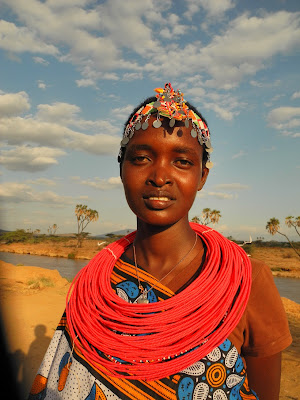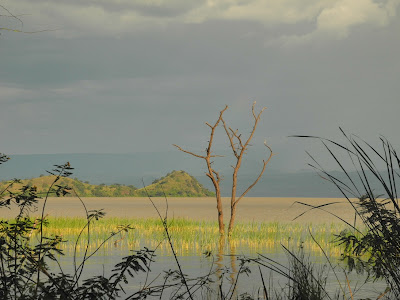
We were left with a couple of days of doing nothing in the small border town of Uganda while waiting for Fred’s Rwandan visa. And as always, when one plan does not work as expected something else comes up. This is how we ended up seeing an active volcano with burning lava and spend a night in the Democratic Republic du Congo! Real adventure, just to keep us entertained for some time longer.

The Nyiragongo volcano is one if the few active ones remaining and one of the even fewer that contain a lave lake. The volcano erupted for the last time in 2002; the city below had time to evacuate leading to ‘only’ 50 fatalities and one quarter of the city being fully destroyed; the previous eruption some 20 years back led to more than 300 deaths. Nowadays the volcano is being monitored by researchers and even has basic tourist facilities.

Whether the Congolese researchers are able to accurately predict an eruption is questionable especially when the over-developed Japanese were not in a position to foresee their earthquake and associated tidal wave, but we decided that this was worth taking the risk.

Almost nobody knows or speaks about it and it is not advertised as one of the major attractions of Eastern Africa, like in the end most of the things that can get the money flowing from the Whiteys. That is because the volcano is in the Congo. In the Easter part of the Democratic Republic du Congo, just above the city of Goma.
 Therefore, another fairly obvious factor to take into account apart from a potential eruption was the general situation on this side of the country.
Therefore, another fairly obvious factor to take into account apart from a potential eruption was the general situation on this side of the country.The history of this area is known and not much needs to be said. The situation however, has been stable for some time now and the volcano can be booked via the very (!) fancy internet booking page of the associated Virungas national park (an initiative by a Dutch NGO). This definitely won some points on the psychological safety scale... Apart from that we had met Manu, a Spaniard, professional backpacker and tour-organiser, who had just spend a week there interacting with the staff of the national park, assessing and organising the situation to begin bringing tourists to the area from next year. He would put us in touch with the rangers and they would take care of us as they did with him.

After a longer brainstorming session we decided that fear is momentary while regret stays forever, we were going!
We were picked up by two rangers at the Congolese border; they helped us with the officials and ensured that we would be back the next day.

They drove us the 100 km to the volcano. The area through which we drove was from the moon; one extinct volcano next to the other, reaching altitudes of 2000 to 3500 meters on the otherwise flat surroundings. Ours, the Nyiragongo could be seen from far, at first we thought it was covered in clouds until we realised that this was smoke/condensation from its burning interior. Holly shit, it is really alive! The whole preparation and thought process had made us kind of overlook this fact; seeing it now was eye-opening.
The drive was also eye-opening and sobering. Army trucks, soldiers, safety blocks, police checks, UN trucks, UN bases, UN fancy Landcruisers, European Union army force, Red Cross tents, Unicef camps and all sorts of other never-heard armed and non-armed NGOs and foreign organisations. In-between them, the Congolese people or better to say the Congolese women and children going on with their lives. Women carrying things like everywhere in Africa, working in the fields, selling and buying vegetables on the markets, kids coming or going to school, playing in front of their houses and in the fields, looking at the fast cars driving by, overlooking all the soldiers around them.
Nobody bothered with us. Being in an official car with two rangers is definitely recommended. We arrived at the volcano after 100 km of shaking along the really bad road. There we met the rest of our hiking group, six more Umzungus from across Europe, one guide and two guards and started the ascension. It took us about 6 hours to climb the 3430 meters to the crater rim. The route up follows the lava path that the last eruption left behind, not the easiest territory to walk on.

We arrived on top, it had been raining almost the whole way up, we were soaked and frozen, up there the temperature was close to zero. Exhausted and frozen we pushed the last 3 meters to the rim only to see, nothing! The mist was too thick... Our guides assured us that it should clear up... It better should!

We tried to warm ourselfes up in the very new, very cute cabins they have built just at the tip of the crater, with rum and a meal of canned sardines and peanuts. It had gotten dark and internally warmer when the guards called us to come out and have a look.
And there is was! About 500 meters below us there was a massive pot with a 1 km diameter of burning red lava. You could see the lava boiling like a pot of water, bubbles and little explosions everywhere. You could even hear it! Even by looking at and hearing it, it was hard to comprehend what we were seeing. We do not realise it but we do live, all of us, on a burning ball of melted earth. Most of us live fully unaware of this, not that it makes any sort of practical difference but it does show you that there are greater forces surrounding us than the ones we get caught up within our daily life.
 All the wars people are fighting below can turn even more useless with only one eruption of the ground they are living on.
All the wars people are fighting below can turn even more useless with only one eruption of the ground they are living on.We tried to take in the view as long as we could stand the cold. The pictures are not the best, we were missing the skills and the equipment but you can see maybe a tiny bit of what we saw.
The next morning we watched the sunrise from the crater rim and then walked back down in wonderful sunshine this time.
The drive back as well as the border crossing was again hassle-free. We arrived back in the town where we had left Cruisi and went for a much dreamt –of lunch to a small cafe owned by a German woman, she even had a freshly baked Rabarbar-Streusel Kuchen!!
Fred’s visa was ready and we crossed the third border in two days, this time into Rwanda.

That was it, we have seen it and we are back again. Back with an amazing experience to remember and a lot to process. The conflict in the Congo is a complex situation and even the guards who we had with us could not tell us what it is about (!?). Speaking to a Human Rights lecturer who is applying for his Doctorate over a beer here on the lake shore of a lovely town of Rwanda we tried to get a better insight. The tensions are reaching far back and have many origins, tribal, territorial, economic (Eastern Congo is one of the richest areas) and political.
 Whether all the foreign ‘help’ from institutions like the UN and other NGOs are effective is ambiguous. Yes, they do maintain stability in the short term allowing women and children (mainly) to go on with their lives as we have seen but in the longer term their presence does not seem to facilitate a clear solution of the conflict but rather support the certain interest groups...
Whether all the foreign ‘help’ from institutions like the UN and other NGOs are effective is ambiguous. Yes, they do maintain stability in the short term allowing women and children (mainly) to go on with their lives as we have seen but in the longer term their presence does not seem to facilitate a clear solution of the conflict but rather support the certain interest groups...
With Gadafi’s death a few days ago the comment of why we Umzungus are interfering so much in African affairs has been raised to us directly and indirectly a couple of times. The beginning of the internal African dilemma in our mind these days...
We are safe and happy, hoping the same for you!









































